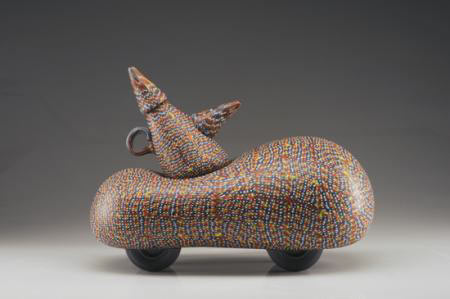
In the late 1960s, Richard Marquis traveled to Italy to study glass sculpture under master blowers on the Venetian isle of Murano. After completing his studies, rather than staying in Venice and practicing the secretive techniques he had learned there, he returned to the United States and shared his knowledge with students here and around the world. This democratizing impulse was a powerful lightning bolt in the perfect storm that electrified the contemporary studio glass movement in the 1970s. In his work now, as then, he combines disparate practices — blowing, kilnforming, fusing, and wheel-cutting among them — to create objects that blend immaculate execution with an obsessive temperament and impish humor.
“Objects of Obfuscation” sees the artist in the grips of a full-blown fascination with the World War I-era camouflage pattern known as Razzle Dazzle. This proto-Op mashup of thick black and white lines jutting together at eye-boggling angles was painted onto warships to confuse enemy boats and submarines as to the vessels’ size, direction, and speed, making them harder to fire on or torpedo. Marquis has created a flotilla of warship-shaped sculptures in motley Razzle Dazzle colors: blue and yellow zigzags abutting checkerboard mosaics in yellow and black, orange and blue, yellow and turquoise. The colors are so bold, the patterns so jarring, and the ships’ forms so reductivist, that the works as a whole effectively obfuscate the dialectic between maximalism and minimalism.
Although primarily known for sculpture, Marquis broadens his reach here to incorporate monoprints and wall panels. In the monoprint series, Marquis sets the vessels at jaunty angles atop backgrounds in richly saturated reds, pinks, chocolate browns, and blues. In the “Razzle Dazzle Boat Panel” series, the artist puts the warship motif through invigorating compositional variations, sometimes presenting the boats as frontally iconic, other times entering the picture plane from the side, imparting a sense of motion. The backward slant of the ships’ steam exhausts adds a menacing touch, evoking the fin of a great white shark slicing through waves.
Because Marquis makes a point never to waste glass, he often incorporates loose chunks and slivers from old pieces into new works. In the “Whole Elk” series of wall panels, he sprinkles would-be detritus from the “Razzle Dazzle” warships into crackly, confetti-like backgrounds, with teapot-like shapes — a recurring motif — in the foreground. This practice harkens to Native Americans’ historic use of the entirety of elk, moose, and buffalo they killed, rather than wasting any part of the creatures, which beyond the economy of use were considered sacred.
The spiritual and political overtones in these panels points to a central paradox in Marquis’ work. He has always deployed a brand of folksy, understated whimsy in the child-like shapes that are his signature — a tactic that softens or disguises (again the emphasis of obfuscation) a more pointed conceptual intent. In the 1970s his well-known murrine teapots, seemingly pulled like taffy into surrealistic contortions, often appeared the very soul of whimsy upon first viewing. They gradually revealed their critique of the grotesque distortions wrought on the contemporaneous American psyche by the specters of the Vietnam War and Watergate. Today, similarly, he leaves us wondering: Could these warships, with their happy colors but sinister contours, have implications to current maritime tensions between North Korea, South Korea, and Japan; or escalating hostilities in the Middle East? Across the breadth of media in this thought-provoking and visually hyper-stimulating exhibition, Marquis suggests that implication may be more potent than explication.
